
The Goeldi's marmoset or Goeldi's monkey is a small, South American New World monkey that lives in the upper Amazon basin region of Bolivia, Brazil, Colombia, and Peru. It is the only species classified in the genus Callimico, and the monkeys are sometimes referred to as "callimicos". The species takes its name from its discoverer, Swiss-Brazilian naturalist Emil August Goeldi.
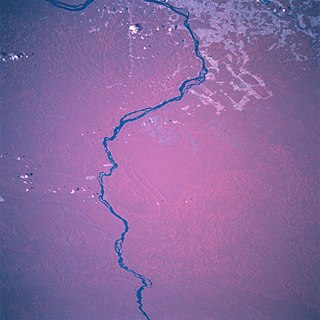
The Xingu River is a 1,640 km (1,019 mi) river in north Brazil. It is a southeast tributary of the Amazon River and one of the largest clearwater rivers in the Amazon basin, accounting for about 5% of its water.
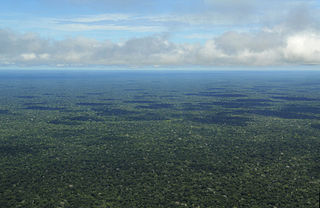
The Amazon rainforest, also called Amazon jungle or Amazonia, is a moist broadleaf tropical rainforest in the Amazon biome that covers most of the Amazon basin of South America. This basin encompasses 7,000,000 km2 (2,700,000 sq mi), of which 5,500,000 km2 (2,100,000 sq mi) are covered by the rainforest. This region includes territory belonging to nine nations and 3,344 formally acknowledged indigenous territories.

Characidae, the characids or characins is a family of freshwater subtropical and tropical fish, belonging to the order Characiformes. The name "characins" is the historical one, but scientists today tend to prefer "characids" to reflect their status as a by and large monophyletic group at family rank. To arrive there, this family has undergone much systematic and taxonomic change. Among those fishes that remain in the Characidae for the time being are the tetras, comprising the very similar genera Hemigrammus and Hyphessobrycon, as well as a few related forms such as the cave and neon tetras. Fish of this family are important as food and also include popular aquarium fish species.

The Amazon river dolphin, also known as the boto, bufeo or pink river dolphin, is a species of toothed whale which is native to and is exclusively of South America classified in the family Iniidae. Three subspecies are currently recognized: I. g. geoffrensis, I. g. boliviensis and I. g. humboldtiana while position of Araguaian river dolphin within the clade is still unclear. The three subspecies are distributed in the Amazon basin, the upper Madeira River in Bolivia, and the Orinoco basin, respectively.
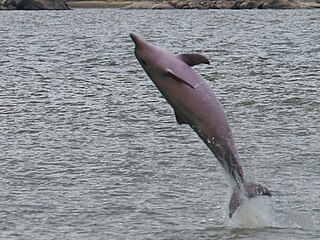
The tucuxi, alternatively known in Peru bufeo gris or bufeo negro, is a species of freshwater dolphin found in the rivers of the Amazon basin. The word tucuxi is derived from the Tupi language word tuchuchi-ana, and has now been adopted as the species' common name. Despite being found in geographic locations similar to those of 'true' river dolphins such as the boto, the tucuxi is not closely related to them genetically. Instead, it is classed in the oceanic dolphin family (Delphinidae).

The Amazon basin is the part of South America drained by the Amazon River and its tributaries. The Amazon drainage basin covers an area of about 7,000,000 km2 (2,700,000 sq mi), or about 35.5 percent of the South American continent. It is located in the countries of Bolivia, Brazil, Colombia, Ecuador, Guyana, Peru, Suriname, and Venezuela, as well as the territory of French Guiana.

Uakari is the common name for the New World monkeys of the genus Cacajao. Both the English and scientific names are believed to have originated from indigenous languages.

The mata mata, mata-mata, or matamata is a freshwater turtle species found in South America, primarily in the Amazon and Orinoco basins. It is one of two extant species in the genus Chelus, the other being Chelus orinocensis.
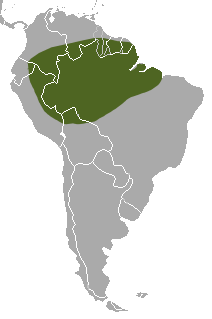
The Amazon weasel, also known as the tropical weasel, is a species of weasel native to South America. It was first identified from a museum specimen mislabelled as coming from Africa, hence the scientific name.

Leporinus is a genus of fish in the family Anostomidae native to South America. The fossil species Leporinus scalabrinii, known from the late Miocene of Entre Ríos in Argentina, has only recently been added to this genus after being misidentified as a species of primate under the name Arrhinolemur scalabrinii for over 100 years.

Baryancistrus is a genus of freshwater Loricariid catfish. They inhabit flowing sections of rivers, especially clearwater, in the basins of the Amazon and Orinoco in Brazil and Venezuela. The largest species reach up to 34 cm (13 in) in total length.

The ocellate river stingray, also known as the peacock-eye stingray or black river stingray, is a species of freshwater stingray in the family Potamotrygonidae. It was the first species to be described in the family and is also the most widespread, ranging throughout much of the Río de la Plata, Amazon, Mearim and Orinoco basins in tropical and subtropical South America. It is sometimes kept in aquaria.

The banded knifefish is a species of gymniform knifefish native to a wide range of freshwater habitats in South America. It is the most widespread species of Gymnotus, but it has frequently been confused with several relatives, including some found outside its range like the Central America G. maculosus. The English name "banded knifefish" is sometimes used for the entire genus Gymnotus instead of only the species G. carapo.
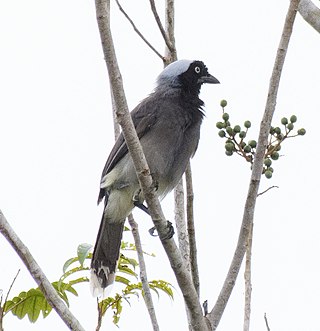
The azure-naped jay is a species of bird in the family Corvidae. It is found in Brazil, Colombia, and Venezuela.

Stenostomidae is a family of freshwater catenulid flatworms. It is the most species-rich family of catenulids, with about 70 species described, most of them in the Neotropics.

The Bolivian river dolphin is a species of the genus Inia.
Aphyodite is a genus of characin in the family Characidae. It contains three species. It was originally described as a monotypic genus containing only Aphyodite grammica, which is endemic to the Essequibo River basin in Guyana; however, two more species were described in 2017: Aphyodite apiaka from the Solimões river basin and Aphyodite tupebas from the Madeira river basin.
Spinipterus is a genus of catfishes of the family Auchenipteridae.
A várzea forest is a seasonal floodplain forest inundated by whitewater rivers that occurs in the Amazon biome. Until the late 1970s, the definition was less clear and várzea was often used for all periodically flooded Amazonian forests.

















